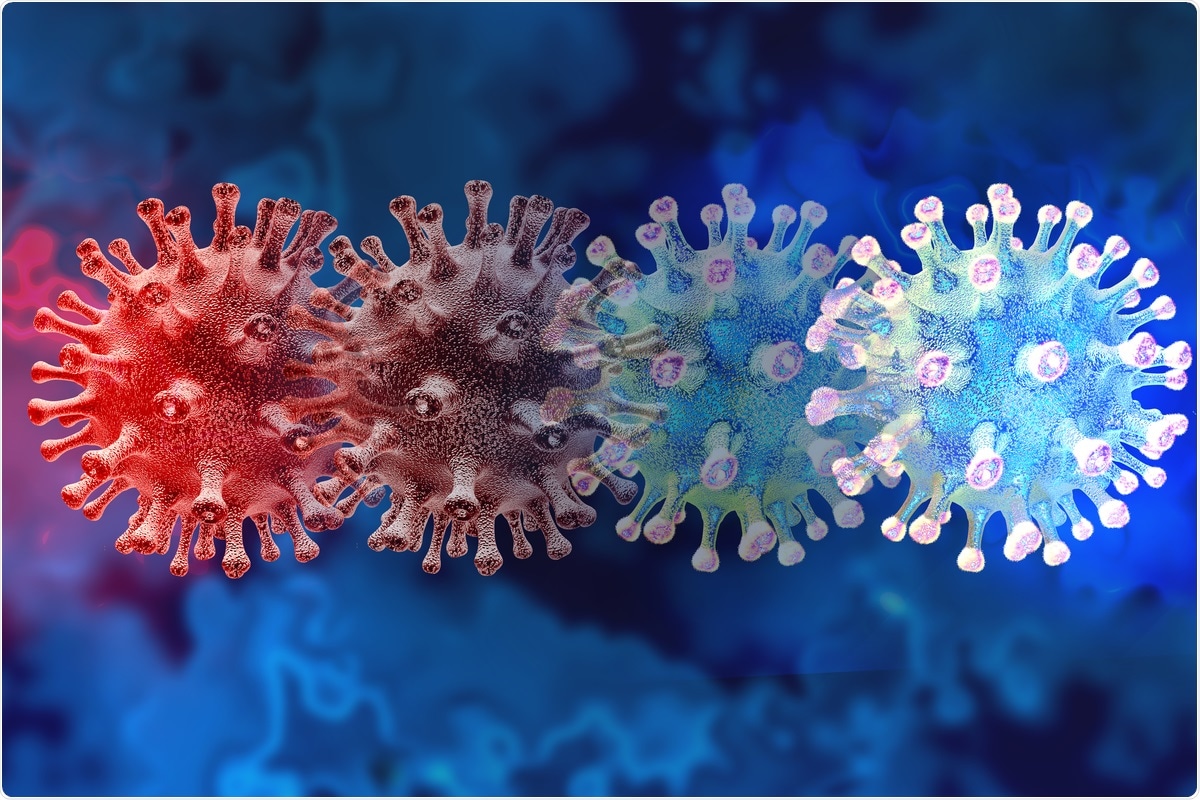In a perspective article recently published in the journal Science, Hyeryun Choe and Michael Farzan from the Scripps Research Institute, USA, have described the early-stage evolution of severe acute respiratory syndrome coronavirus 2 (SARS-CoV-2) in humans. They have provided a detailed overview of how early mutations in SARS-CoV-2 spike protein facilitate its adaptation in human systems.

How does SARS-CoV-2 enter human cells?
The spike glycoprotein on the viral envelope is the main entry protein of SARS-CoV-2 that initiates viral entry into human cells. Upon binding to the angiotensin-converting enzyme 2 (ACE2) receptor on the human cell membrane, the spike protein undergoes a series of conformational changes, which collectively result in viral entry and infection establishment.
Structurally, the spike protein contains two subunits (S1 and S2) and is present on the viral envelope as a trimer. In a trimeric form, three S1 subunits sit on top of a trimeric S2 stalk. The receptor-binding domain (RBD) in the S1 subunit efficiently recognizes and binds the human ACE2 receptor to initiate the viral entry process. The spike RBD constantly switches between an “up” position for ACE2 binding or a “down” position for immune evasion. Immediately after spike RBD – ACE2 interaction, proteolytic cleavage and priming of the spike protein at the S1/S2 boundary are carried out by human cell proteases, such as TMPRSS2. Upon proteolytic cleavage, the S1 subunit dissociates, and the S2 unit undergoes massive conformational changes, leading to a fusion between the viral envelope and the human cell membrane and subsequent viral entry.
What are the initial stages of SARS-CoV-2 adaptation in humans?
Soon after its emergence in December 2019 in China, SARS-CoV-2 had started spreading very rapidly all over the world, infecting a large proportion of the global population. On March 11, 2020, the World Health Organization (WHO) had declared the SARS-CoV-2 outbreak a global pandemic.
In January 2020, the D614G missense mutation was identified as the first concerning mutation in the viral spike protein. This mutation is characterized by aspartic acid to glycine shift at position 614. SARS-CoV-2 variants containing D614G mutation have shown a significantly increased infectivity and soon become the predominantly circulating strain worldwide.
Spike cleavage by furin-like proteases
Upon identification of D614G mutation, severe structural and functional studies have been carried out to investigate its impact on viral infectivity and virulence. Initially, as an attempt to improve the efficiency of the SARS-CoV-2 pseudovirus system, scientists have mutated the spike protein site that is cleaved by furin-like proteases. These furin-site mutations, which maintained the covalent linkage between S1 and S2 subunits, have been found to significantly increase the cell-infecting ability of pseudoviruses. With this observation, scientists become curious about the importance of having a furin-cleavage site at the S1/S2 boundary, which apparently reduces the spike protein function in cell culture. In this context, a hypothesis has been developed that furin-mediated spike pre-cleavage in infected cells may promote TMPRSS2-mediated spike priming at the target cell membrane, which in turn is essential for SARS-CoV-2 to enter target cells.
Interestingly, the acquisition of D614G mutation has been found to exclude the need for mutating SARS-CoV-2 furin-cleavage site to improve its infectivity. According to the available literature, viruses carrying the D614G mutation have a significantly higher replication rate in the upper respiratory tract (primary site for transmission) than those carrying the original D614 spike. In contrast, no significant difference in replication has been observed between two viral variants in the lower respiratory tract, which is the primary site for disease severity. Taken together, these observations indicate that although D614G mutation increases viral infectivity, it has no impact on virulence. This is in sharp contrast to the recently identified N501Y spike mutation, which is known to influence both infectivity and virulence of SARS-CoV-2.
D614G mutation and viral fitness
Regarding the impact of the D614G mutation on viral fitness, studies have shown that this mutation shifts the spike protein conformation toward a prefusion state to improve ACE2 binding efficiency. In addition, there is evidence indicating that the D614G mutation strengthens the S1 – S2 interaction to prevent S2 from prematurely reaching a postfusion state. This subsequently facilitates SARS-CoV-2 to have more functional spike proteins for binding and infecting target cells.
Recently, an in-depth structural analysis of G614-carrying spike protein has identified a visibly greater ordering of a region covering residues 620 to 640 in G614 spike protein. This region is termed “630 loop”. The presence of D614G mutation facilitates a more stable and tight accommodation of the “630 loop” between the amino-terminal and carboxy-terminal domains of spike protein.
In viral variants containing D614 spike, the “630 loop” is more disordered, which makes the RBD-up state easily accessible. However, once this conformation is achieved, the dissociation between S1 and S2 subunits occurs rapidly and prematurely. In contrast, for the G614 spike, the S1/S2 dissociation occurs slowly because the “630 loop” continues to hold the trimer together. Taken together, D614G mutation increases SARS-CoV-2 infectivity by preventing premature S1 dissociation.
To reduce the rate of S1/S2 dissociation, some of the currently available vaccines (Moderna and Pfizer-BioNTech) have either introduced recombinant prolines into the S2 subunit or mutated the furin-site. These vaccines, although developed against the original D614 spike, are expected to have better efficacy against SARS-CoV-2 variants.